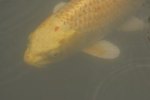
Aquarium test strips are a necessary tool if you want to keep the fish in your aquarium alive and healthy long-term. Test strips are used to test the water in your aquarium, and identify any specific chemicals, toxins or problems, such as ammonia, that are present in your tank's water at levels that could cause significant health concerns for your fish.
5-in-1 Test Strips
Most aquarium enthusiasts use a 5-in-1 test strip to provide them with a general idea of the quality of the water in their fish tank, and to alert them of any developing problems with water quality. A 5-in-1 test strip normally includes testing for pH, nitrate, nitrite, hardness and alkalinity. However, it is important to read the box before your buy your test strips because some tests vary on exactly what is being tested. For example, some tests will include chlorine instead of hardness, or they will test for multiple types of hardness instead of alkalinity. The test you need will be determined by the specific water needs of the fish you keep in your aquarium.
Ammonia Test Strips
Ammonia test strips are sold individually because the method for testing for ammonia is slightly different than the quick dip-and-read method used for the 5-in-1 tests. Ammonia tests must be swirled around in the water sample for approximately 10 seconds before they can give an accurate reading. Ammonia can be extremely toxic to fish and it is absolutely necessary to test your tank for ammonia content.
Reading Your 5-in-1 Test Strips
Read the instructions for the specific product you have purchased. Your testing strips came with a color chart that shows what each color on your testing strip means. Dip your test strip in a small, fresh sample of your aquarium water and then give the test strip a moment to show results. Note, you cannot let your test strip sit, because it will continue to turn colors as time passes, ultimately leading to inaccurate results. You must check your results within 30 seconds of performing your test. Once your test strip has changed colors, read it by placing it next to your color chart and matching the colors on the testing strip to the colors on the chart. Each color will be representative of the amount of the specific component you were testing for that is present in your water.
Reading Your Ammonia Test Strip
Your ammonia test strip spends more time in the water than do your 5-in-1 test strips. After you remove your ammonia test strip from the water, wait 10 seconds and then match your test strip to the color chart that came with your testing strips to find out how much ammonia is in your water.
References
Photo Credits
-
Photodisc/Digital Vision/Getty Images
Writer Bio
Jen Davis has been writing since 2004. She has served as a newspaper reporter and her freelance articles have appeared in magazines such as "Horses Incorporated," "The Paisley Pony" and "Alabama Living." Davis earned her Bachelor of Arts in communication with a concentration in journalism from Berry College in Rome, Ga.




